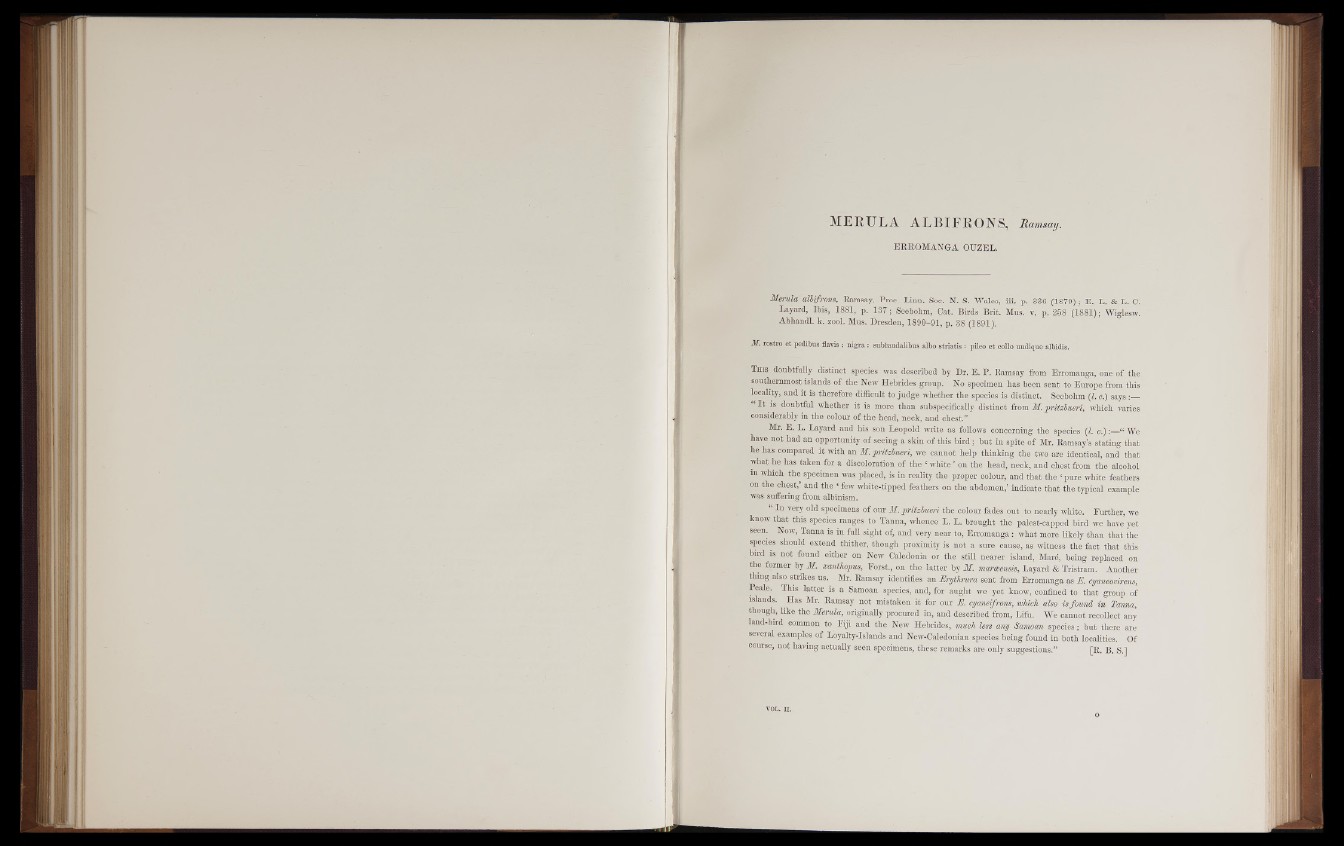
M E R U L A A L B I F R O N S , Ramsay.
ERROMANGA OUZEL.
Merula alhifrons, Ramsay, Proc. Linn. Soc. N. S. Wales, f fl p. 336 (1879); E. L. & L. C.
Layard, Ibis, 1881, p. 137; Seebohm, Cat. Birds Brit. Mus. v. p. 258 (1881); Wiglesw.
Abhandl. k. zool. Mus. Dresden, 1890-91, p. 38 (1891).
M. rostro et pedibus flavia : nigra : subfcaudalibus albo striatis : pileo et.collo undique albidis.
T h is doubtfully distinct species was described by Dr. E. P . Ramsay from Erromanga, one of the
southernmost-islands of the New Hebrides group. No specimen has been sent to Europe from this
locality, and it is therefore difficult to judge whether the species is distinct. Seebohm (I. c.) says :—
I t is doubtful whether it is more than subspecifically distinct from M. pritzbueri, which varies
considerably in the colour of the head, neck, and chest.”
Mr. E. L. Layard and his son Leopold write as follows concerning the species (I. c .):—“ We
have not had an opportunity of seeing a skin of this bird ; but in spite of Mr. Ramsay’s stating that
he has compared it with an M. pritzbueri, we cannot help thinking the two are identical, and that
what he has taken for a discoloration of the * white ’ on the head, neck, and chest from the alcohol
in which the specimen was placed, is in reality the proper colour, and that the ‘pure white feathers
on the chest,’ and the ‘ few white-tipped feathers on the abdomen,’ indicate that the typical example
was suffering from albinism.
“ In very old specimens of our M. pritzbueri the colour fades out to nearly white. Further, we
know that this species ranges to Tanna, whence L. L. brought the palest-capped bird we have yet
seen. Now, Tanna is in full sight of, and very near to, Erromanga: what more likely than that the
species should extend thither, though proximity is not a sure cause, as witness the fact that this
bird is not found either on New Caledonia or the still nearer island, Mare, being replaced on
the former by M. xanthopus, Forst., on the latter by M. marceensis, Layard & Tristram. Another
thing also strikes us. Mr. Ramsay identifies an Erythrura sent from Erromanga as E. cyaneovirens,
Peale. This latter is a Samoan species, and, for aught we yet know, confined to that group of
islands. Has Mr. Ramsay not mistaken it for our E. oyaneifrons, which also isfmmd in Tanna,
though, like the Merula, originally procured in, and described from, Lifu. We cannot recollect any
land-bird common to Fiji and the Ngw Hebrides, much less any Samoan species; but there are
several examples of Loyalty-Islands and New-Caledonian species being found in both localities. Of
course, not having actually seen specimens, these remarks are only suggestions.” [R. B. S.]
VOL. II. o